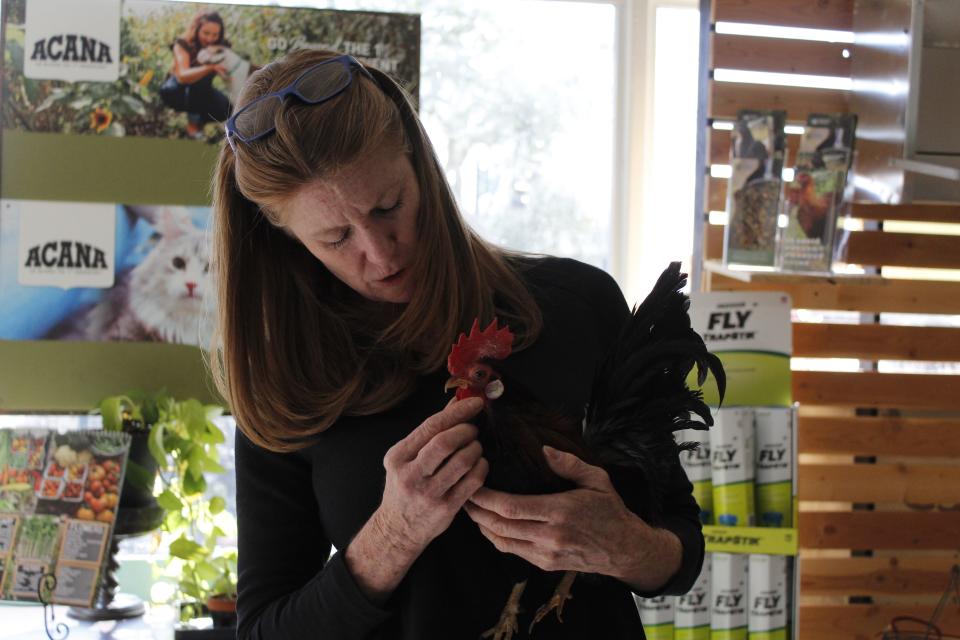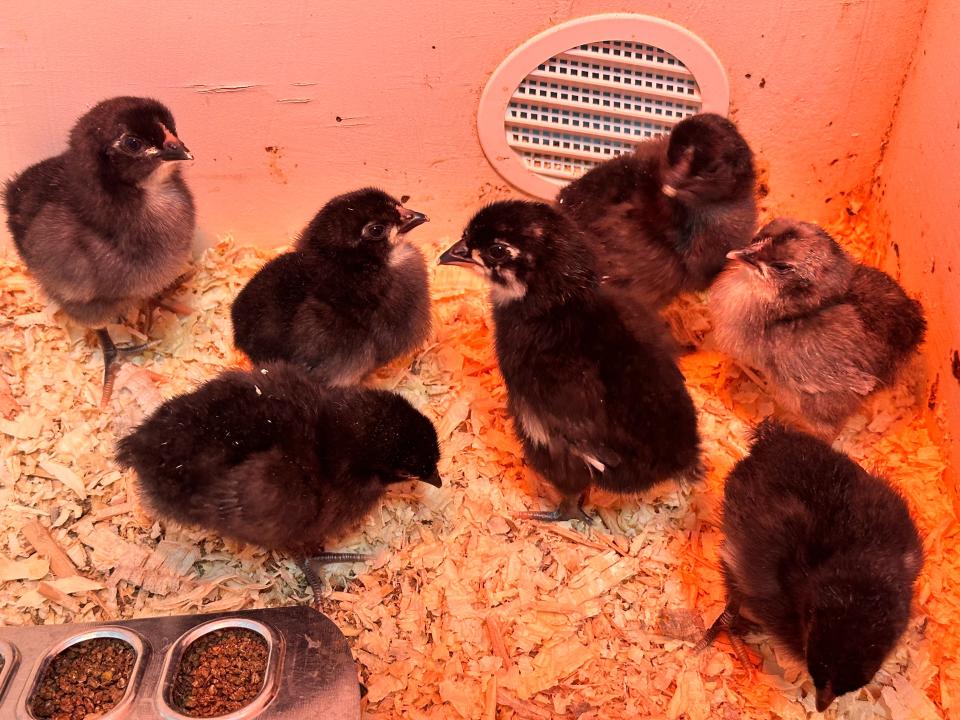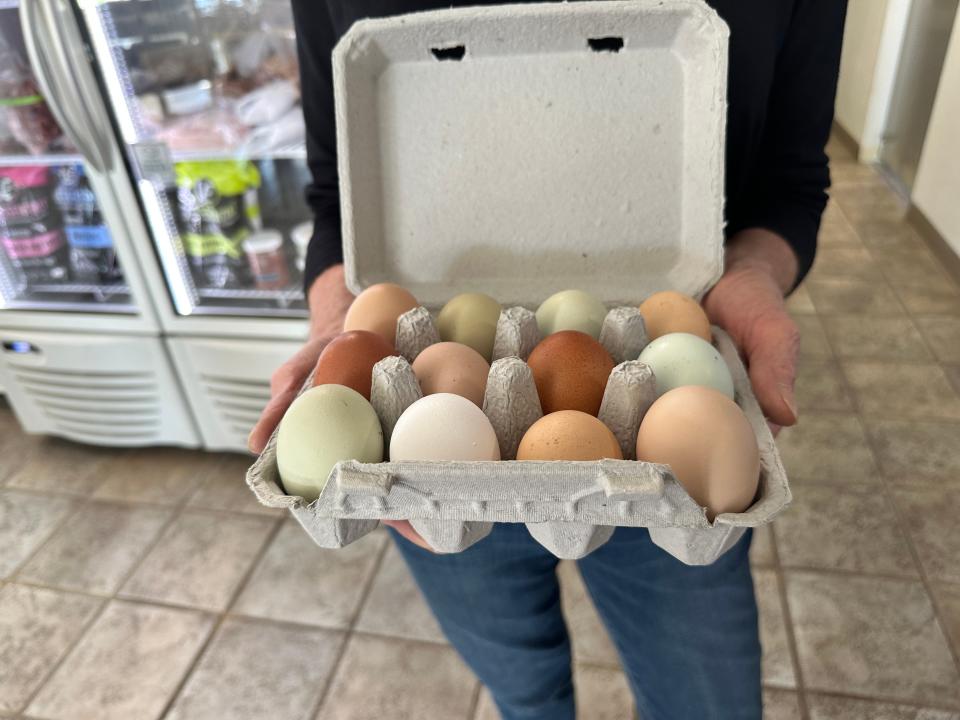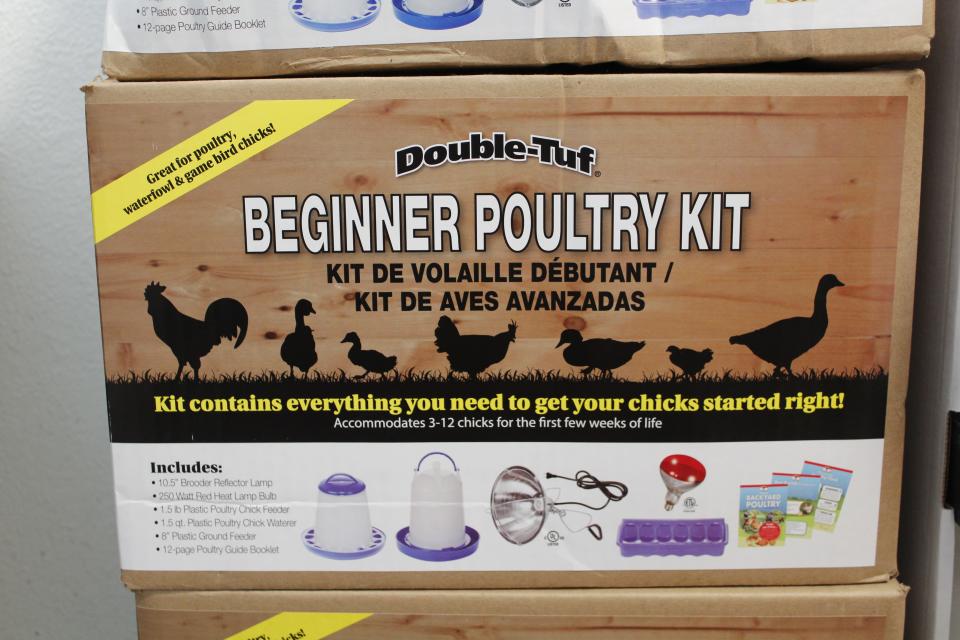High egg prices have Arizonans buying chickens. Here's what to know before you start
The memes and TikTok videos are flowing on social media poking fun at the rise in cost of eggs, but for many cash-strapped families, the added expense isn't funny.
Increasingly, as one local vendor noticed, some are taking matters into their own hands.
Surrounded by construction and old buildings in the middle of downtown Mesa is Inspire Farms, a shop that sells everything from chicken feed to raw locally produced milk.
Toward the back of the store, tucked into mini coops, are dark feathered chicks illuminated by the red glow of a heating lamp.
Store owner Tiffiny Lilley has seen an uptick in sales for her chicks and chicken coop startup kits. Before it took her three days to sell out of her chicks, now takes an hour, Lilley said. She saw the demand begin at the height of the pandemic but during the past three months, she’s had more customers come in asking how to get started.

She gets 100 to 300 chicks in her store every week and she sells each one. Customers even preorder the chicks on her store website.
Egg prices have more than doubled over the last year largely due to an outbreak of bird flu in commercial poultry facilities.
From backyard chickens to best friends

Lilley began breeding and selling chicks and chickens in 2017 before opening her storefront in downtown Mesa in 2020. Her face shines with passion talking with customers about the differences between breeds and egg colors.
‘I’m here to educate,” she said. She encourages and supports her customers as best she can to make sure they can be successful.
She’s there to answer any questions from the type of chicken breed to buy to how to care for them. She said conversations with customers often start with the question: "How many eggs do you eat a week?" That helps the customer decide what to buy because the amount of eggs a chicken lays depends on the breed.
“Everybody wants a Silkie chicken,” she said, partly because of their popularity and cuteness. Silkies are known for their fluffy white or yellow feathers and funny-looking faces. But the downside is they don’t lay nearly as many eggs as other breeds do. A white-and-black average-looking Delaware chicken can lay up to 260 large eggs a year, while a Silkie produces only 100 small eggs a year.

If people want pretty eggs, she suggests getting a “boring” looking chicken. Not that the color of the egg makes much difference in taste, Lilley said.
The taste differences come from what the chicken eats. “The better you feed your chicken, the better the egg,” she said. That’s why at her store she sells soy and corn-free chicken feed to ensure her chickens get sufficient minerals and vitamins.
Apart from being egg producers, Lilley said they can be great pets. Chickens can recognize up to 100 faces and are easy to train, she said. On top of the companionship, they’re good pest control because they'll eat any the bugs in the backyard, Lilley said.
Lilley says more than one chick is needed to start off. “Chickens are social animals,” she said. If they don’t have friends, the chickens don’t do as well and won't be good egg producers.
“Happy hens lay more eggs,” she said.
By the numbers
So what does it take to start your own backyard chicken coop? Before you dive into a full-time avian commitment, you'd be wise to ponder the egg-onomics. The supply list starts off with the chicks, feed, heat lamps, a coop and more.
She recommends beginners start off with four to five chicks.
Chicks at her store range from $8 to $15, depending on the breed. The feed can cost upward of $60 depending on the size bag that could last up to six weeks. A beginner poultry kit costs $46, which includes the heating lamp, two feeders and waterer.
Once chicks are fully feathered, after about four to six weeks, Lilley said it’s important to get them into their backyard chicken coop.
There are options on the type of chicken coop people might want to park in their backyard. Lilley said people could build one, buy one online such as off Wayfair or go for the ones she sells. Her Amish-built small chicken coop houses up to five chickens at a cost of $1,300.
She said her coops are built to last and endure Arizona’s harsh summer weather.

It could cost upward of $1,500 to start this endeavor. Lilley pointed out that a lot of that is one-time costs. The main recurring cost will be the chicken feed, which a 60-pound bag could last about six weeks for four chickens.
Lilley said feed can be supplemented with kitchen scraps like the tops of strawberries. Her motto is to only feed the chicken what a person would be willing to eat. "No mold, no slime, no grossness," she said.
Patience will be key when starting this journey. It takes four to six months before a chicken lays its first egg. The first two years are a chicken’s best egg-laying years, Lilley said. Once chickens get older, they start to slow down, but the upside is the size of the egg gets larger.
With four good egg-laying chickens, folks could expect an average of 20 eggs a week. That amounts to 86 dozen eggs a year.
Based on the average price of a dozen of eggs, that would amount to $365.50 a year in value. However, prices range depending on the brand and size of the egg. That means, if you go for the top-line Amish coop, it could take four years for your chicken investment to pencil out.
The average life span of chickens is around two years, but they can live up to 10 years if well taken care of. Disease and predators are chicken's main cause of death.
Backyard chicken eggs have stronger shells, darker yolks and a better taste, according to Lilley. Eggs also have a longer shelf life because private coops are not processed and cleaned like commercial poultry facilities.
Folks will also want to check their city ordinances before getting started. Most cities in the Valley have backyard chicken ordinances that detail how many chickens are allowed within a certain lot size. Mesa residents can have up to 10 chickens on the first half acre or less. Roosters are allowed as long as they don’t create a noise disturbance.
Most recently, Chandler changed its ordinance to allow up to five chickens per yard. Before folks get started building their chicken coop, they may also want to check their homeowner association's rules regarding backyard chickens.
While Lilley sees the uptick in chick sales to be temporary, she still advocates people raising chickens.
“Chickens are really great for your heart and for your health. They’re a win-win,” she said.
Reporter Maritza Dominguez covers Mesa/Gilbert and can be reached at maritza.dominguez@arizonarepublic.com or 480-271-0646. Follow her on Twitter @maritzacdom.
This article originally appeared on Arizona Republic: Egg prices are rising. What to know about raising chickens

